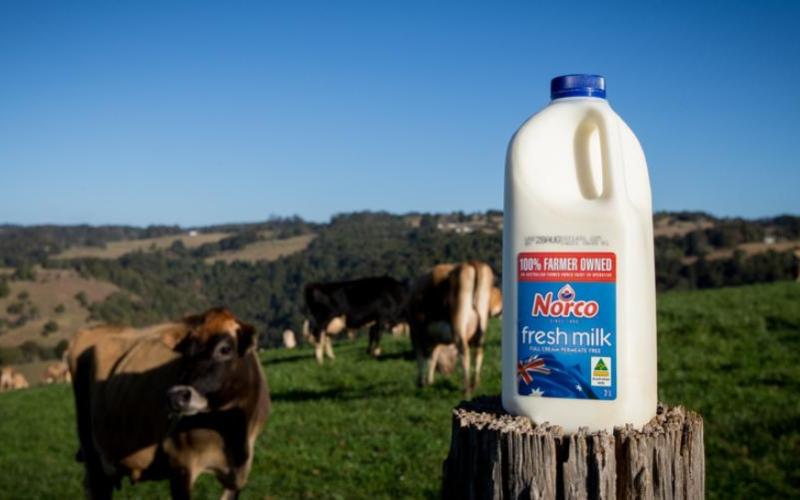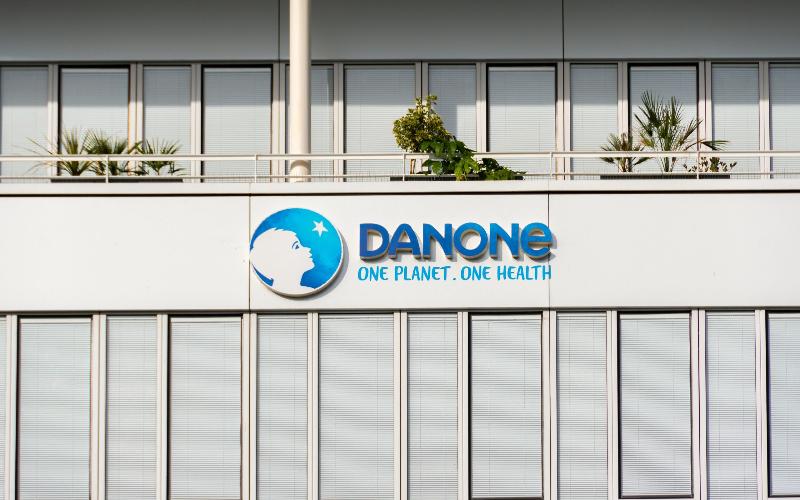Dairy Farms in Ukraine Reached Pre-War Milk Production Levels in 2023
Source: The DairyNews
In 2023, dairy farms in Ukraine increased milk production volumes, reaching pre-war levels, while a decline in milk yields was observed in household farms.

Analyst Georgiy Kukhaleyshvili from the Milk Producers Association highlights that since 88% of milk for processing is produced by dairy farms, the crises in the household sector have limited impact on supplying raw materials to dairy processing enterprises.
According to State Statistics, in 2023, farms of all categories produced approximately 7,412 thousand tons of raw milk, a 5% decrease compared to the previous year. In December 2023, milk yields in Ukraine amounted to 589.7 thousand tons, an 8% increase compared to November and a 7% decrease compared to December 2022. During this period, 38% of raw milk production came from enterprises, and 62% from household farms.
Industrial enterprises increased milk production to 2,807 thousand tons (+6%) in January-December 2023. Dairy farms reached pre-war milk production levels. For comparison, the industrial sector produced 2,767 thousand tons of raw milk in 2021. In December 2023, yields on enterprises amounted to 234.4 thousand tons of raw milk, a 1% increase compared to November and a 7% decrease compared to December 2022.
In household farms, 4,604.3 thousand tons of milk were produced in the 12 months of 2023, an 11% decrease from the previous year. In December 2023, yields in household farms were 355.3 thousand tons, a 12% increase from November and a 7% decrease compared to December 2022.
Kukhaleyshvili notes that the overall reduction in raw milk production in Ukraine is primarily due to a decline in yields in household farms, which have been significantly affected by the consequences of Russia's full-scale invasion. Many Ukrainians left their cows in occupied territories, leading to unaccounted-for or confiscated cattle sold for meat. Additionally, the culling of animals injured during the war contributes to reducing livestock. Feeding conditions have worsened due to fields and pastures contaminated with mines and shells, rendering them unsuitable for use. The unresolved issue of updating dairy farm infrastructure adds to the challenges, as most structures were built during the Soviet era and no longer meet modern conditions.
Dairy farmers face a shortage of working capital, credit funds, and state subsidies, mainly focused on supporting the crop sector. Costs for fuel, electricity, and feed production have increased. Small farms are unable to increase production costs, making dairy farms with herds of over 400 cows the most profitable and resilient to challenges. Notably, 88% of milk for processing comes from the industrial sector, making the reduction in yields in household farms less impactful on industrial-scale milk production.
Ukraine is gradually transitioning milk food processing exclusively to extra-grade raw materials, which dairy farms are capable of producing. According to a Ministry of Agrarian Policy order from March 12, 2019, after the end of the state of war, dairy processing enterprises will be able to use only extra-grade milk that complies with European quality standards.
In January-December 2023, the growth in raw milk production was observed in farms of all categories in the Kyiv Oblast (+5%), Cherkasy Oblast (+4%), Khmelnytskyi Oblast (+3.9%), Chernihiv Oblast (+3%), Rivne Oblast (+3%), Poltava Oblast (+2%), and Kharkiv Oblast (+2%).
Around 51% of raw milk was produced in the following regions in January-December 2023:
Khmelnytskyi Oblast - 699 thousand tons
Poltava Oblast - 676 thousand tons
Vinnytsia Oblast - 606 thousand tons
Ternopil Oblast - 489 thousand tons
Cherkasy Oblast - 460 thousand tons
Zhytomyr Oblast - 432 thousand tons
Chernihiv Oblast - 414 thousand tons
Regarding beef production, State Statistics estimates that in January-December 2023, the slaughter volume of cattle in all categories was 469.7 thousand tons, a 3% increase compared to the previous year. In December, slaughter volumes amounted to 119 thousand tons, a 67% increase compared to November and only a 0.2% (200 tons) decrease compared to December 2022. Enterprises produced 34% of beef from the total slaughter volume, while household farms contributed 66%.
Slaughter volumes of cattle in enterprises in January-December of the current year were 161.7 thousand tons, a 16% increase compared to the previous year. In December, slaughter volumes in enterprises were 34.2 thousand tons, a 64% increase compared to November and a 2% decrease compared to December of the previous year.
In household farms, slaughter volumes of cattle for the 12 months of 2023 amounted to 308 thousand tons, a 4% decrease compared to the previous year. In December 2023, slaughter volumes in household farms were 84.8 thousand tons, a 68% increase compared to November of the current year and a 0.5% increase compared to December 2022.
The total slaughter volumes of agricultural animals, not only cattle but also pigs, sheep, and poultry, in 2023 are estimated at 3,113.6 thousand tons, a 1.8% increase compared to 2022. In January-December 2023, 50% of meat in Ukraine was produced in farms of all categories in the following regions:
Vinnytsia Oblast - 672 thousand tons
Cherkasy Oblast - 457 thousand tons
Dnipropetrovsk Oblast - 363 thousand tons
Kyiv Oblast - 233 thousand tons
Lviv Oblast - 208 thousand tons
According to State Statistics, an increase in sales volumes of live animals for slaughter occurred in the Kyiv Oblast (+13.6%), Khmelnytskyi Oblast (+8%), Dnipropetrovsk Oblast (+9%), and Rivne Oblast (+6.9%) in 2023.
According to State Statistics, in 2023, farms of all categories produced approximately 7,412 thousand tons of raw milk, a 5% decrease compared to the previous year. In December 2023, milk yields in Ukraine amounted to 589.7 thousand tons, an 8% increase compared to November and a 7% decrease compared to December 2022. During this period, 38% of raw milk production came from enterprises, and 62% from household farms.
Industrial enterprises increased milk production to 2,807 thousand tons (+6%) in January-December 2023. Dairy farms reached pre-war milk production levels. For comparison, the industrial sector produced 2,767 thousand tons of raw milk in 2021. In December 2023, yields on enterprises amounted to 234.4 thousand tons of raw milk, a 1% increase compared to November and a 7% decrease compared to December 2022.
In household farms, 4,604.3 thousand tons of milk were produced in the 12 months of 2023, an 11% decrease from the previous year. In December 2023, yields in household farms were 355.3 thousand tons, a 12% increase from November and a 7% decrease compared to December 2022.
Kukhaleyshvili notes that the overall reduction in raw milk production in Ukraine is primarily due to a decline in yields in household farms, which have been significantly affected by the consequences of Russia's full-scale invasion. Many Ukrainians left their cows in occupied territories, leading to unaccounted-for or confiscated cattle sold for meat. Additionally, the culling of animals injured during the war contributes to reducing livestock. Feeding conditions have worsened due to fields and pastures contaminated with mines and shells, rendering them unsuitable for use. The unresolved issue of updating dairy farm infrastructure adds to the challenges, as most structures were built during the Soviet era and no longer meet modern conditions.
Dairy farmers face a shortage of working capital, credit funds, and state subsidies, mainly focused on supporting the crop sector. Costs for fuel, electricity, and feed production have increased. Small farms are unable to increase production costs, making dairy farms with herds of over 400 cows the most profitable and resilient to challenges. Notably, 88% of milk for processing comes from the industrial sector, making the reduction in yields in household farms less impactful on industrial-scale milk production.
Ukraine is gradually transitioning milk food processing exclusively to extra-grade raw materials, which dairy farms are capable of producing. According to a Ministry of Agrarian Policy order from March 12, 2019, after the end of the state of war, dairy processing enterprises will be able to use only extra-grade milk that complies with European quality standards.
In January-December 2023, the growth in raw milk production was observed in farms of all categories in the Kyiv Oblast (+5%), Cherkasy Oblast (+4%), Khmelnytskyi Oblast (+3.9%), Chernihiv Oblast (+3%), Rivne Oblast (+3%), Poltava Oblast (+2%), and Kharkiv Oblast (+2%).
Around 51% of raw milk was produced in the following regions in January-December 2023:
Khmelnytskyi Oblast - 699 thousand tons
Poltava Oblast - 676 thousand tons
Vinnytsia Oblast - 606 thousand tons
Ternopil Oblast - 489 thousand tons
Cherkasy Oblast - 460 thousand tons
Zhytomyr Oblast - 432 thousand tons
Chernihiv Oblast - 414 thousand tons
Regarding beef production, State Statistics estimates that in January-December 2023, the slaughter volume of cattle in all categories was 469.7 thousand tons, a 3% increase compared to the previous year. In December, slaughter volumes amounted to 119 thousand tons, a 67% increase compared to November and only a 0.2% (200 tons) decrease compared to December 2022. Enterprises produced 34% of beef from the total slaughter volume, while household farms contributed 66%.
Slaughter volumes of cattle in enterprises in January-December of the current year were 161.7 thousand tons, a 16% increase compared to the previous year. In December, slaughter volumes in enterprises were 34.2 thousand tons, a 64% increase compared to November and a 2% decrease compared to December of the previous year.
In household farms, slaughter volumes of cattle for the 12 months of 2023 amounted to 308 thousand tons, a 4% decrease compared to the previous year. In December 2023, slaughter volumes in household farms were 84.8 thousand tons, a 68% increase compared to November of the current year and a 0.5% increase compared to December 2022.
The total slaughter volumes of agricultural animals, not only cattle but also pigs, sheep, and poultry, in 2023 are estimated at 3,113.6 thousand tons, a 1.8% increase compared to 2022. In January-December 2023, 50% of meat in Ukraine was produced in farms of all categories in the following regions:
Vinnytsia Oblast - 672 thousand tons
Cherkasy Oblast - 457 thousand tons
Dnipropetrovsk Oblast - 363 thousand tons
Kyiv Oblast - 233 thousand tons
Lviv Oblast - 208 thousand tons
According to State Statistics, an increase in sales volumes of live animals for slaughter occurred in the Kyiv Oblast (+13.6%), Khmelnytskyi Oblast (+8%), Dnipropetrovsk Oblast (+9%), and Rivne Oblast (+6.9%) in 2023.
Key News of the Week














